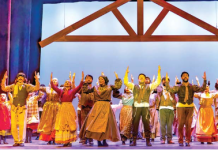By M. J. Alvarez |
As the weather gets warmer, one of the best ways of getting an effective, low-impact workout is to hit the road with your bike.
But you don’t have a bike, you say? This article is intended as a short primer on buying a bike that you will really want to ride this summer.
The first and most important thing to know about purchasing a bike is that it must fit you properly. Fit is a function of height and leg length so bikes come in different sizes based on the measurement from the center of the bottom bracket where the cranks and pedals are attached to the top of the seat – or “saddle,” in cycling parlance. Fit is adjusted through saddle height and the reach to your handlebars.
For the first-time purchaser, this is probably more than you want or need to know about bike-fit so the answer is to buy your bike from a bike store, i.e. a store that only sells bikes and related gear. The sales teams at these stores can assist you in picking out a bike that fits you properly. Prices at bike stores are higher than at warehouse-like stores but you will get a high-quality bike that is comfortable and that you will want to ride. The most expensive piece of sports equipment you own is probably the one you don’t use – remember that Nordic Track you bought a couple of years ago that now servers as a high-tech clothes drying rack?
“It’s about getting the right bike to fit for the right needs of the rider,” said Jeff Bisbee, a manager of Trek Bicycle Store in Middletown. “And the bikes are professionally assembled by certified bicycle mechanics, which is important for safety.”
As the weather gets warmer, one of the best ways of getting an effective, low-impact workout is to hit the road with your bike.
But you don’t have a bike, you say? This article is intended as a short primer on buying a bike that you will really want to ride this summer.
The first and most important thing to know about purchasing a bike is that it must fit you properly. Fit is a function of height and leg length so bikes come in different sizes based on the measurement from the center of the bottom bracket where the cranks and pedals are attached to the top of the seat – or “saddle,” in cycling parlance. Fit is adjusted through saddle height and the reach to your handlebars.
For the first-time purchaser, this is probably more than you want or need to know about bike-fit so the answer is to buy your bike from a bike store, i.e. a store that only sells bikes and related gear. The sales teams at these stores can assist you in picking out a bike that fits you properly. Prices at bike stores are higher than at warehouse-like stores but you will get a high-quality bike that is comfortable and that you will want to ride. The most expensive piece of sports equipment you own is probably the one you don’t use – remember that Nordic Track you bought a couple of years ago that now servers as a high-tech clothes drying rack?
“It’s about getting the right bike to fit for the right needs of the rider,” said Jeff Bisbee, a manager of Trek Bicycle Store in Middletown. “And the bikes are professionally assembled by certified bicycle mechanics, which is important for safety.”
Today bikes come in three different flavors – hybrid, mountain and road. During your visit to the bike store, the sales associate can help you decide what type of bike would best fit the type of riding you want to do.
For a first-time buyer who wishes to ride around the neighborhood for distances less than 10 miles at a time, a hybrid bike will probably fit the bill. These bikes are called “hybrid” because they are a cross between road bikes and mountain bikes. They have wider saddles and tires designed to be ridden on roads – including light gravel and fire roads – and bike paths. The handlebars on these bikes put the rider in an upright position.
For a first-time buyer who wishes to ride around the neighborhood for distances less than 10 miles at a time, a hybrid bike will probably fit the bill. These bikes are called “hybrid” because they are a cross between road bikes and mountain bikes. They have wider saddles and tires designed to be ridden on roads – including light gravel and fire roads – and bike paths. The handlebars on these bikes put the rider in an upright position.
At the other two ends of the spectrum are mountain bikes and road bikes.
Mountain bikes put the rider in a position similar to a hybrid bike but have gnarly tires intended for dirt trails. Some of them even come with suspension to allow for travel over obstacles such as roots or downed tree trunks. Many first time buyers gravitate to mountain bikes because they think that the fat tires will provide greater comfort on roads but this is not necessarily the case. Mountain bikes are really designed to be ridden almost exclusively on trails.
At the other end of the spectrum are road bikes. These bikes are suitable for longer rides on paved roads and are designed to be ridden long distances. Serious cyclists can ride for more than 100 miles at a time on road bikes that fit properly. Road bikes are characterized by English- style “drop” handlebars and narrower tires and saddles. At first glance road bikes look uncomfortable but a properly fitting road bike is the most comfortable bike you can purchase. The drop handlebars allow for multiple hand positions which relieve pressure points in the palms and arms and the less-than-upright position of the rider on a road saddle also takes pressure off your bum. Many riders who start out on hybrid bikes eventually purchase a road bike as they get more serious about the sport.
Mountain bikes put the rider in a position similar to a hybrid bike but have gnarly tires intended for dirt trails. Some of them even come with suspension to allow for travel over obstacles such as roots or downed tree trunks. Many first time buyers gravitate to mountain bikes because they think that the fat tires will provide greater comfort on roads but this is not necessarily the case. Mountain bikes are really designed to be ridden almost exclusively on trails.
At the other end of the spectrum are road bikes. These bikes are suitable for longer rides on paved roads and are designed to be ridden long distances. Serious cyclists can ride for more than 100 miles at a time on road bikes that fit properly. Road bikes are characterized by English- style “drop” handlebars and narrower tires and saddles. At first glance road bikes look uncomfortable but a properly fitting road bike is the most comfortable bike you can purchase. The drop handlebars allow for multiple hand positions which relieve pressure points in the palms and arms and the less-than-upright position of the rider on a road saddle also takes pressure off your bum. Many riders who start out on hybrid bikes eventually purchase a road bike as they get more serious about the sport.
Once you have selected your bike there is one more piece of equipment you must purchase and use every time you throw your leg over the top tube of your bike – a cycling helmet. Again, this is where making your purchase at a proper bike store is essential. They only sell helmets that are properly certified for cycling – the so-called CPSC standard. Wear your helmet on all your biking trips, even if it’s just around the block or to the corner store.
So have fun out there on your bike this summer. Create your own refreshing breezes even on the warmest of summer days.
TIPS FOR SAFE ROAD RIDING
New Jersey law provides that “every person riding a bicycle on a roadway is granted all the rights and is subject to all of the duties of a motor vehicle driver.” With that said, here are some tips for safe road riding.
• Follow all traffic laws. Act like a car – stop at all STOP signs and obey all traffic signals. Signal when turning.
• Ride on the right side of the road in the direction of traffic but do not ride so far to the right that you are riding in the gutter where there may be dangerous road debris.
• Be visible to drivers. Wear bright colors especially on parts of your body that are in motion such as the legs. Ideally use daytime running lights red flashing for the rear attached to your seat tube and white flashing for the front on your handlebars. These can be purchased at bike stores. They are very light and unobtrusive on your bike and highly visible to drivers. Many LED models can be recharged via a USB connection so you can be sure to always leave the house with a full charge.
• Be predictable to drivers. Avoid sudden moves into lanes of traffic. When crossing in front of a car at an intersection, make eye contact with the driver so you are sure he sees you. If you are approaching a car ahead of you parked on the right side of the road, assume that the driver’s side door will be opening so, after signaling, ride wide enough to allow for the door to open in front of you.
New Jersey law provides that “every person riding a bicycle on a roadway is granted all the rights and is subject to all of the duties of a motor vehicle driver.” With that said, here are some tips for safe road riding.
• Follow all traffic laws. Act like a car – stop at all STOP signs and obey all traffic signals. Signal when turning.
• Ride on the right side of the road in the direction of traffic but do not ride so far to the right that you are riding in the gutter where there may be dangerous road debris.
• Be visible to drivers. Wear bright colors especially on parts of your body that are in motion such as the legs. Ideally use daytime running lights red flashing for the rear attached to your seat tube and white flashing for the front on your handlebars. These can be purchased at bike stores. They are very light and unobtrusive on your bike and highly visible to drivers. Many LED models can be recharged via a USB connection so you can be sure to always leave the house with a full charge.
• Be predictable to drivers. Avoid sudden moves into lanes of traffic. When crossing in front of a car at an intersection, make eye contact with the driver so you are sure he sees you. If you are approaching a car ahead of you parked on the right side of the road, assume that the driver’s side door will be opening so, after signaling, ride wide enough to allow for the door to open in front of you.
This article first appeared in the May 24-31, 2018 print edition of The Two River Times.














